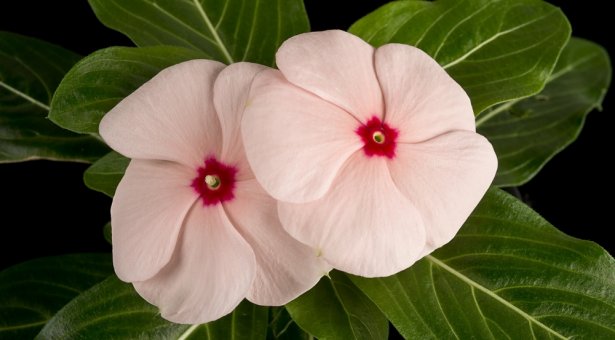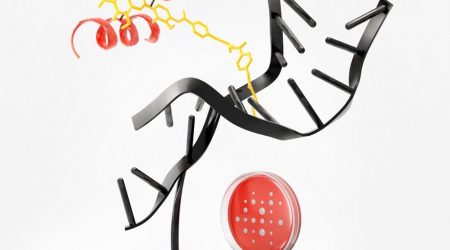Vinblastine and vincristine: life-saving drugs from a periwinkle

Catharanthus roseus, also known as Madagascar periwinkle, is a small perennial plant native to the island of Madagascar.
Its attractive white or pink flowers have made it a popular ornamental plant in gardens and homes across the world.
As well as their decorative use, medicinal healers in various regions, including India, Philippines and South Africa, have long used infusions made from the leaves of the Madagascar periwinkle to treat several conditions, specifically diabetes.
The discovery of insulin and its subsequent commercialisation by the pharmaceutical company Eli Lilly, at the beginning of the 20th century, represented the major breakthrough in the treatment of diabetes.
However, as studies began to demonstrate that insulin was 100% effective and some of those receiving the treatment were developing resistance, researchers started looking for new lead compounds.
Among the alternatives was a herbal preparation of leaves, named Vinculin, that was initially marketed in the UK in the 1930s. However, it wasn’t until the 1950s that the Madagascar periwinkle came under the spotlight.
Two research teams (one from the pharmaceutical company Eli Lilly and the other from University of Western Ontario), independently began testing the biological effects of the plant extracts in the hope of identifying possible new drugs for treatment of diabetes.
They were in for a surprise.
While the plant extracts were not very effective in lowering blood sugar levels in mice, they dramatically decreased the number of white cells in their blood.
Since some types of cancer, such as leukaemia, involve a proliferation of white blood cells, the researches quickly realised that Madagascar periwinkle extracts could contain a chemical (or chemicals) with potential cancer-fighting properties.
Dr Robert Noble, from the University of Western Ontario, presented his findings at a conference that was attended also by researchers from Eli Lilly. The groups then got together and discussed their preliminary results, deciding to join forces.
Their collaboration led to the rapid identification, development and advancement of two closely related drugs from the periwinkle’s extract; vinblastine and vincristine.
In the 1960s, vinblastine and vincristine were approved by the US Food and Drug Administration as chemotherapeutic agents for the treatment of several types of cancer.
Since then, vincristine, which inhibits leukocyte production and maturation, has been successfully used for treatment of childhood acute lymphoblastic leukaemia and non-Hodgkin lymphomas, increasing the chance of surviving from 10% to 95%.
Meanwhile, vinblastine, a potent inhibitor of cell division, has been used in combination with other chemotherapy drugs against lymphomas as well as testicular, ovarian, breast, bladder and lung cancers.
The chemical structures of vinblastine and vincristine are quite complex and the mechanisms by which the plant produces these chemicals are not yet fully understood. They can be classified as alkaloids, a large group of natural products consisting of several ring structures containing one or more nitrogen atoms.
As such, access to these chemicals is only possible through extraction from the Madagascan periwinkle.
Methods have been developed to synthesise these drugs starting from precursors, called catharanthine and vindoline, also isolated from the plant.
However, today approximately 500 Kg of dried leaves are required to produce 1 g of vinblastine.
In this context, the possibility to increase the yield through synthetic biology would allow to overcome the challenges of having a steady supply and possibly decrease the price of the drugs, allowing more people to have access to treatment.
Professor Sarah O’Connor wants to answer some of the challenging questions related to the biosynthesis of these chemicals.
Particularly she is trying to investigate the whole sequence of metabolic events that the Madagascan periwinkle deploys in order to produce vinblastine and vincristine.
In the past few years, her research group has been able to identify key genes involved in their production but a few are still missing.
Once the whole pathway is completed, it will be possible to engineer other organisms, either microorganisms or plants, to increase the world supply of these valuable chemicals.
Hopefully, her efforts will allow us to harness the medicinal potential of this remarkable plant, known to people leaving in tropical climates as a weed and to western gardeners as an easy-to-grow ornamental, which has already saved thousands of lives.
References
- R. Cooper and J. J. Deakin, Botanical miracles: chemistry of plants that changed the world. CRC Press, 2016.
- Duffin J. Poisoning the spindle: serendipity and discovery of the anti-tumor properties of the Vinca alkaloids. Pharm. Hist. 2002, 44 (2): 64-76.
- R.C. Noble, C.T. Beer, and J.H. Cutts, Role of chance observations in chemotherapy: Vinca rosea, Annals of the New York Academy of Sciences, 1958, 76 (3): 882-894.


